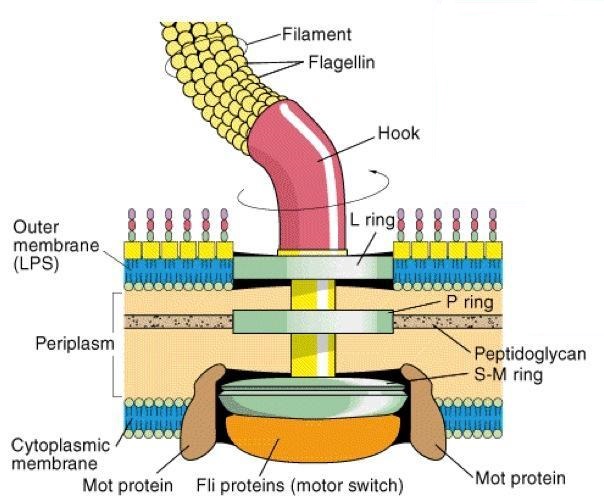
- Bacterial flagella are hairlike, helical appendages that protrude through the cell wall.
- They are responsible for motility in bacteria and are much thinner than the flagella or cilia of eukaryotes.
- They are much simpler in structure and are 0.01-0.02µm in diameter.
- A flagellum is composed of three parts:
- Basal body:
- It is associated with the cytoplasmic membrane and cell wall of bacteria.
- Basal body of Gram negative bacteria consists of 4 rings; L, P, S and M rings.
- L- ring is associated with the outer membrane and P- ring is with the peptidoglycan layer.
- Both S and M rings are associated with the cell membrane.
- In case of Gram positive bacteria, the outer L-ring is absent.
- Basal body acts as a motor for the rotation of flagella.
- A short hook
- Filament: a thin helical filament which is usually several times as long as the cell
- Basal body:

- Some Gram negative bacteria have a sheath surrounding the flagellum which is continuous with the outer membrane of the Gram negative cell wall.
- The filament of the flagellum is made up of single fibril, composed of a protein called flagellin.
- Unlike a hair, a flagellum grows at its tip rather than at the base.
Arrangement of flagella in bacteria:
- On the basis of arrangement in the bacterial cell, flagella are of following types:
- Monotrichous: it is a single polar(at one or both ends of the cell) flagellum e.g. Pseudomonas aeruginosa
- Lophotrichous: a cluster of flagella lie at one end or pole of the cell. e.g. Pseudomonas florescence
- Amphitrichous: either single or cluster of flagella lies at both the ends of the cell. e.g. Aquaspirillum serpens
- Peritrichous: flagella are present all over the cell surface. e.g. Escherichia coli
Mechanism of flagellar rotation:
- Flagella are the organelles of motility in bacteria and are responsible for swimming motility.
- Mot protein acts as a starter to rotate flagellum and helical filament of flagellum rotates in screw type motion either in clockwise or anti-clockwise direction.
- This rotation of flagellum either pushes or pulls the bacterial cell.
- Proton gradient provides the necessary energy for the rotation of flagella.
- When proton flows through the Mot protein, it attracts the opposite charge on M and S rings of flagellar basal body, thus rotating the flagella in screw type motion.
Types of flagellar motility:
- Reversible flagellar motility:
- Bacteria with polar flagella move by two mechanisms.
- Flagella of some bacteria rotate in both directions, such flagella are called reversible flagella.
- In such bacteria, at first flagella rotate in one direction and make the bacteria move forward and to move in reverse direction, bacteria change the direction of rotation of flagella.
- Unidirectional flagellar motility:
- Flagella of some bacteria rotate only in one direction.
- In such bacteria, to change the direction of movement, bacteria first should stop and orient to change the direction again.
- Such motility is unidirectional motility of flagella.
- Peritrichous flagellar motility:
- In bacteria with peritrichous flagella, flagellar motility is different.
- At first, peritrichous flagella assemble at one pole forming a bundle which then rotates in anti-clockwise direction and pushes the bacteria forward.
- To change the direction of movement, flagella rotate in clockwise direction, by which flagella unwind or release from the bundle and bacteria tumble.
- Flagellar bundle is formed again on the other pole and bundle rotates in anti-clockwise direction and bacteria move in a new direction.
Types of motility in bacterial cells:
- There are two types of motility in bacteria;
- Gliding motility:
- This type of motility occurs in bacteria without flagella.
- Bacteria glide on solid surface only and is comparatively slower than swimming motility. e.g. Flavobacterium, Myxobacteria.
- Swimming motility:
- This type of motility occurs in water with the help of flagella.
- It can be reversible, unidirectional or like in peritrichous flagella.
- It is faster than gliding motility. e.g. Proteus spp, Escherichia coli, Vibrio cholerae etc.
- Gliding motility: